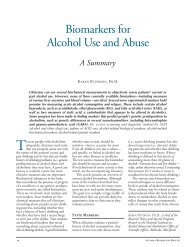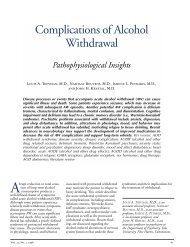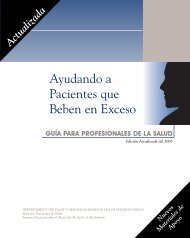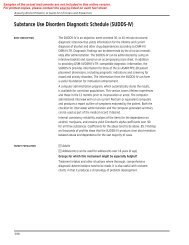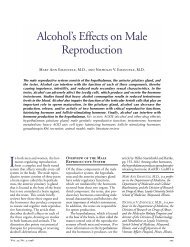Alcohol Syndrome (FAS) and Other Alcohol-Related Birth Defects
Alcohol Syndrome (FAS) and Other Alcohol-Related Birth Defects
Alcohol Syndrome (FAS) and Other Alcohol-Related Birth Defects
Create successful ePaper yourself
Turn your PDF publications into a flip-book with our unique Google optimized e-Paper software.
that one drink each day. It is expected that self-reported data showing a relationship<br />
between moderate use <strong>and</strong> alcohol-related birth defects may often underestimate the<br />
true level of drinking. High peak blood levels of alcohol are important predictors of<br />
adverse outcome. Binge exposures (at least 5 st<strong>and</strong>ard drinks on any occasion) result in<br />
a greater frequency of neurological sequellae than the same amount of alcohol<br />
distributed across a greater time course.<br />
Certainly, the best advice is to totally abstain from alcohol use during pregnancy,<br />
even at stages prior to the time that pregnancy is recognized. Although some clinicians<br />
believe that recommending total abstention for pregnant women may subject them to<br />
unwarranted guilt about drinking small amounts of alcohol, most accept the need for<br />
clinical caution. Because it is not known at what dosage alcohol damage begins, it<br />
is prudent to recommend that pregnant women abstain from alcohol use<br />
(transparency #7). In spite of public warnings the Centers for Disease Control reports a<br />
fourfold increase in frequent drinking from 1991-1995 among pregnant women<br />
In addition to considering consequences of alcohol exposure prior to birth, it is<br />
also important to note that alcohol that a lactating mother consumes is present in her<br />
milk <strong>and</strong> may affect the brain of her nursing infant.<br />
ARBDs are expensive. For one person with <strong>FAS</strong>, the institutional <strong>and</strong> medical<br />
costs over a lifetime have been estimated to be between $800,000 to $2 million<br />
(www.nofas.org, 2004; <strong>and</strong> Addiction Biology, Vol 9., No. 2, 2004). Recent estimates<br />
indicate that total annual costs of care to US society are as high as $7.8 billion for<br />
individuals with <strong>FAS</strong> (Addiction Biology, Vol 9., No. 2, 2004).<br />
PREVENTION<br />
The traditional ARBD prevention approach of focusing intervention efforts during<br />
pregnancy is after much damage has already occurred. Physicians <strong>and</strong> other health care<br />
providers should encourage sexually-active childbearing age alcohol consumers to<br />
prevent pregnancy or to avoid any alcohol use during preconceptional <strong>and</strong> prenatal<br />
periods.<br />
Ideally, appropriate screening of all childbearing age patients for alcohol use<br />
combined with preconception health promotion, contraceptive counseling, <strong>and</strong> referral to<br />
substance abuse programs for high risk consumers should become a routine st<strong>and</strong>ard of<br />
care in primary care settings. Serving this role, physicians <strong>and</strong> other health care<br />
providers will play a critical role in the primary prevention of <strong>FAS</strong> <strong>and</strong> other ARBDs.<br />
Education of physicians, other health care providers, parents, <strong>and</strong> prospective<br />
parents is essential!!



